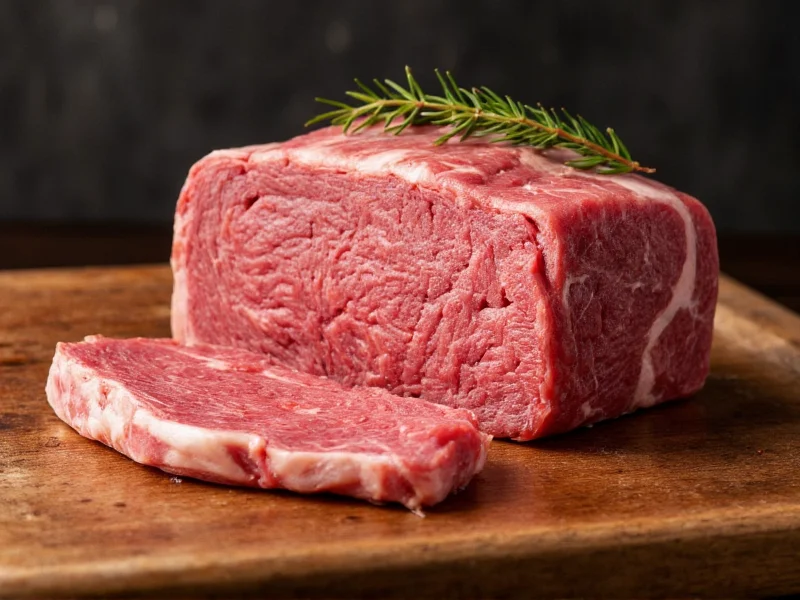When preparing pulled beef, selecting the right cut makes all the difference between dry, stringy results and succulent, melt-in-your-mouth perfection. The chuck roast earns its top position for pulled beef preparation due to its anatomical composition. Located in the shoulder area of the cow, this cut works hard during the animal's life, developing substantial connective tissue and marbling that transforms during slow cooking.
Why Chuck Roast Reigns Supreme for Pulled Beef
Chuck roast typically comes from the shoulder region, which contains approximately 20-30% fat content when properly trimmed. This fat distribution creates the perfect conditions for pulled beef preparation. During the slow cooking process (typically 8-12 hours at low temperatures), the collagen in the connective tissue converts to gelatin, while the marbling melts throughout the meat, keeping it moist and flavorful.
Professional pitmasters and culinary experts consistently recommend chuck roast for pulled beef because it maintains structural integrity during cooking while still breaking down sufficiently for easy shredding. Unlike leaner cuts that become dry, or extremely fatty cuts that turn greasy, chuck roast hits the sweet spot for texture and flavor absorption.
Alternative Cuts for Pulled Beef
While chuck roast stands as the premier choice, several alternatives work well depending on availability and personal preference:
| Cut of Beef | Advantages | Disadvantages | Best Cooking Method |
|---|---|---|---|
| Chuck Roast | Ideal fat content, excellent flavor, consistent results | Requires trimming, slightly higher cost than some alternatives | Slow cooker, smoker, oven braising |
| Brisket (Point Cut) | Rich flavor, traditional barbecue choice | Longer cooking time, more expensive, can become dry if overcooked | Smoker, low-temperature oven |
| Round Roast | Leaner option, more affordable | Less marbling, higher risk of dryness, requires careful monitoring | Slow cooker with additional liquid |
| Short Ribs | Exceptional flavor, good marbling | More expensive, bones complicate shredding process | Braising, then removing bones before shredding |
Selecting the Perfect Chuck Roast
Not all chuck roasts deliver equal results. When shopping for the best cut for pulled beef, look for these characteristics:
- Marbling: Visible white streaks of fat throughout the meat indicate proper marbling. Avoid cuts that appear too lean.
- Color: Fresh chuck roast should have a bright cherry-red color. Avoid grayish or brownish hues.
- Texture: The meat should feel firm to the touch, not slimy or sticky.
- Size: For most home cooking applications, a 3-4 pound roast provides ideal results without excessive leftovers.
- Grade: USDA Choice grade offers the best balance of marbling and value for pulled beef preparation.
Optimal Cooking Methods for Chuck Roast Pulled Beef
The chuck roast's composition makes it exceptionally versatile across cooking methods. For the most tender pulled beef:
Begin by seasoning your chuck roast generously with salt and pepper. For enhanced flavor, consider a dry rub with paprika, garlic powder, onion powder, and a touch of brown sugar. Sear the roast on all sides in a hot skillet to develop flavor through the Maillard reaction before transferring to your cooking vessel.
Slow cooking at 225-250°F (107-121°C) for 8-12 hours allows the collagen to fully convert to gelatin without drying out the meat. The internal temperature should reach 195-205°F (90-96°C) for optimal shreddability. At this temperature range, the meat will pull apart effortlessly with forks while retaining moisture.
Many home cooks wonder about chuck roast vs brisket for pulled beef. While brisket produces excellent results, it requires more precise temperature control and longer cooking times. Chuck roast offers more consistent results for beginners while remaining forgiving of minor temperature fluctuations.
Common Mistakes to Avoid
Even with the best cut of beef, several pitfalls can compromise your pulled beef results:
- Insufficient cooking time: Removing the meat before connective tissues fully break down results in tough, chewy texture
- High cooking temperatures: Cooking above 275°F (135°C) causes muscle fibers to contract excessively, squeezing out moisture
- Skipping the sear: The initial sear develops complex flavor compounds through caramelization
- Over-trimming fat: Removing too much external fat eliminates essential moisture and flavor during cooking
- Rushing the resting period: Allowing the cooked meat to rest for 30-60 minutes lets juices redistribute
Testing for Doneness
Don't rely solely on cooking time or temperature when preparing pulled beef. The most reliable test involves using two forks to pull the meat apart. Properly cooked chuck roast should separate with minimal resistance, almost falling apart on its own. If you need to apply significant pressure, return it to the cooker for another hour.
The ideal pulled beef texture features strands that maintain their integrity but separate easily. Overcooked beef becomes mushy and loses its appealing texture, while undercooked beef remains stringy and tough.
Storage and Reheating Tips
Properly stored, cooked pulled beef maintains quality for up to four days in the refrigerator or up to three months in the freezer. For best results:
- Store with some of the cooking liquid or au jus to maintain moisture
- Use airtight containers to prevent flavor transfer and drying
- When reheating, add a small amount of liquid and warm gently over low heat
- Avoid microwaving without added moisture, which can make the beef rubbery
For meal preppers seeking the most tender beef for pulled beef recipe, consider portioning the cooled meat into meal-sized containers with just enough cooking liquid to coat. This approach preserves texture while making weeknight meals effortless to prepare.
Conclusion
While various cuts can produce acceptable pulled beef, the chuck roast remains the gold standard for home cooks and professionals alike. Its ideal fat-to-meat ratio, consistent availability, and forgiving nature during cooking make it the best beef cut for slow cooker pulled beef and other preparation methods. When selecting your cut, prioritize well-marbled chuck shoulder roasts and allow sufficient cooking time at proper temperatures for the most succulent, flavorful pulled beef possible.











 浙公网安备
33010002000092号
浙公网安备
33010002000092号 浙B2-20120091-4
浙B2-20120091-4